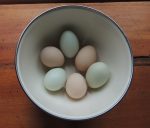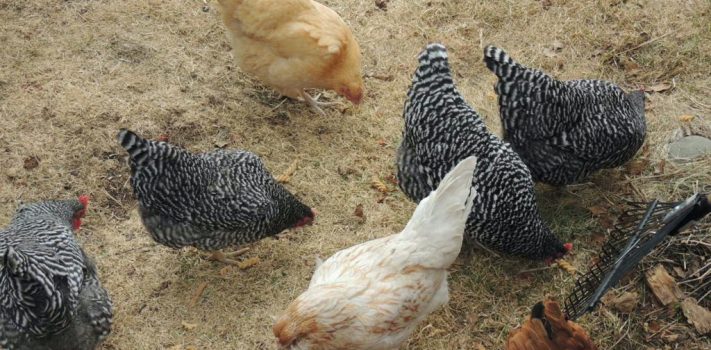Egg laying is partially predicated on the season. Our hens, of various breeds, are always most prolific layers in the summer months. In the autumn, when they molt (shed their feathers and grow new ones) they do not lay at all for 6 to 8 weeks. During the cold winter months in Alaska, they shiver in the chilly coop, laying maybe half as often as in the summer. It is only in March, when we have 12 hours of daylight, that they venture out into the snow and start to lay regularly again.
Therefore, I learned various ways to save eggs to eat during the molt and all winter long.
Note: In the USA, people who buy eggs at a supermarket are purchasing eggs that are washed, which removes the bloom, which is a clear thin coating that the hen naturally produces as she lays to protect the egg from bacteria and dirt. This is why, in this country, eggs are stored in the refrigerator.
In the many other countries that do not wash the shells first, shopkeepers store eggs on room temperature shelves, and millions of shoppers store them at home this way, too, up to about 21 days, depending on ambient temperature.
Since we do not wash our hens’ eggs either. I store them in a large metal bowl on a kitchen counter for up to three weeks. If I am surfeited with eggs, I store them long-term in the various ways listed below.
The following are my experiences and opinions. Someone else’s could be different.
HOW TO TEST EGGS FOR FRESHNESS
Put any questionable eggs in a deep, flat-bottomed pot and cover them with water. If any float, air has gotten inside the shell and you do not want to eat them. If they rise slightly off the bottom and turn sideways, I cook them sooner than the eggs that do not rise or tip at all.
LONG-TERM EGG STORAGE
GLASSING
I do not know why the term, “glassing” is used for this technique, which involves submerging raw eggs (in their shells) in a food grade lime solution (like pickling lime) and setting the crock or food grade bucket somewhere, undisturbed, at room temperature. I have successfully cooked with eggs that I glassed and stored at room temperature for nine months. I have read in Mother Earth News, that people have stored them for two years. The most I have stored for 9 months is 125, in two food grade 5 gallon buckets with lids.
To make the solution, I measured out a proportion of 8:1 water to pickling lime, and then heated the water enough that the lime dissolves, stirring thoroughly. After it cools to room temperature, I pour it into a food grade bucket and gently place unwashed, fresh eggs into the water, making sure that no egg shells rise above the solution. Over time, the solution will sink to the bottom, so it is important to gently stir up that bottom layer, to recoat the shells. I do this once a month.
One year, I neither heated the water nor stirred once a month. Big mistake! The eggs on the bottom layer were practically cemented to each other in the lime, but the eggs above the bottom layer rotted. What a noxious job it was to pull those out and toss away 60 eggs! Plus, I hate wasting food.
When cooking with the eggs that have been glassed for several months, I rinse them first, and then crack them into a transitional bowl to check. I find that both the yolks and whites are runnier than fresh eggs, so they are better suited to scrambling, custards, or baking than for fried eggs.
IMPORTANT: This treatment works only for farm fresh, unwashed eggs that still have the protective “bloom” on the shell.
FREEZING
1) FAVORED: Raw beaten eggs can be poured into muffin tins or ice cube trays, frozen, and then popped out to be stored in plastic bags or other containers. It is helpful to measure the amount of one eggy ice cube for future recipes. I found that a muffin tin holds about an egg and a half, and my ice cube trays held less than one egg. These individual units thaw quickly. When scrambled, the texture of these frozen, raw eggs is the same as unfrozen, raw eggs. I rarely separate eggs and yolks for recipes, but you can do so and freeze the beaten raw yolks separately from the raw whites. Either way, freezing raw eggs in measured portions is a very convenient and reliable method.
2) NOT FAVORED: Hard boiled eggs can be frozen in or out of the shell. Shelled eggs will crack when the interior expands in the cold. Either way, the texture of the white will be rubbery but the yolk will feel normal.. I freeze whole eggs as a winter treat for my dog or hens, but I would not serve them to people.
3) VARIABLE RESULTS: Raw, eggy recipes, like quiche, pancake batter, etc. can be made in advance, packaged well, and frozen, to be thawed overnight for cooking the next morning. I have done so short term with a number of brunch dishes for large gatherings. NOTES: a) Like anything in a freezer, if it is not wrapped well and if it is frozen long term, it will develop ice crystals, making the recipe more watery. (b) Many raw vegetables do not freeze well, but cooked vegetables do.
PICKLING
My husband and I are not fans of pickled eggs, but many people like them. To me the texture is rubbery and the vinegar/egg combo is unappealing. However, my father-in-law told me that “back in the day” pickled eggs were a staple snack food, often free, on the bar at pubs.
SAVING EGG SHELLS
I utilize all the egg shells, too.
1) If you want to reduce the bitterness of a batch of coffee, drop a half egg shell in your percolator or coffee maker.
2) To give my dog extra calcium, I grind up dried egg shells and sprinkle it on his food.
3) I crush hundreds of eggshells each year and distribute the material in my gardens. The shells have several benefits: calcium, of course, and the texture lightens heavy soil, and the sharp edges are supposed to deter slugs and other soft bodied pests, although the amount of eggshells in my gardens has never deterred slugs in rainy summers.
 In conclusion, we love raising hens for fresh eggs and all the other benefits that hens bring to our homestead. As with any summer bounty, like zucchini, it is useful to figure out how to save eggs for later in the year and how to utilize the shells. Waste not, want not! Don’t take July’s production for granted. Planning ahead for low productivity later in the year will be well rewarded.
In conclusion, we love raising hens for fresh eggs and all the other benefits that hens bring to our homestead. As with any summer bounty, like zucchini, it is useful to figure out how to save eggs for later in the year and how to utilize the shells. Waste not, want not! Don’t take July’s production for granted. Planning ahead for low productivity later in the year will be well rewarded.
—
Mrs. Alaska blogs about her off-grid life at a remote cabin in the interior of Alaska at: https://alaskauu1.blogspot.com/










